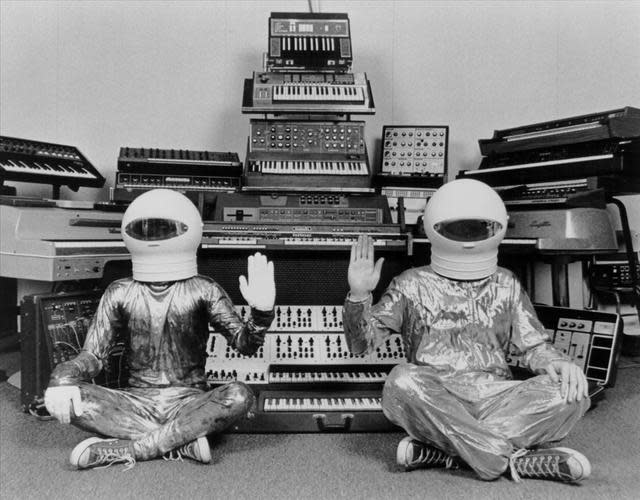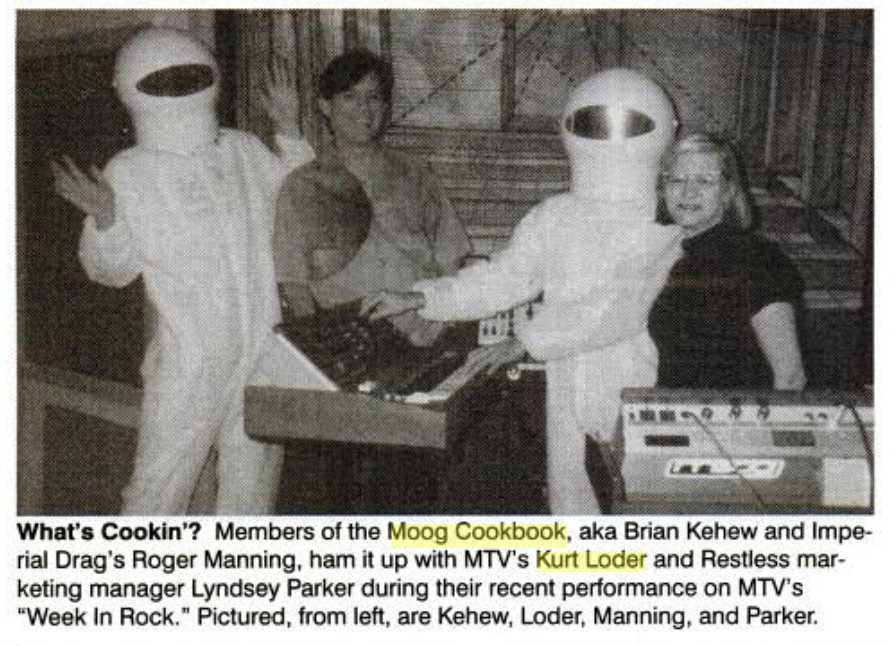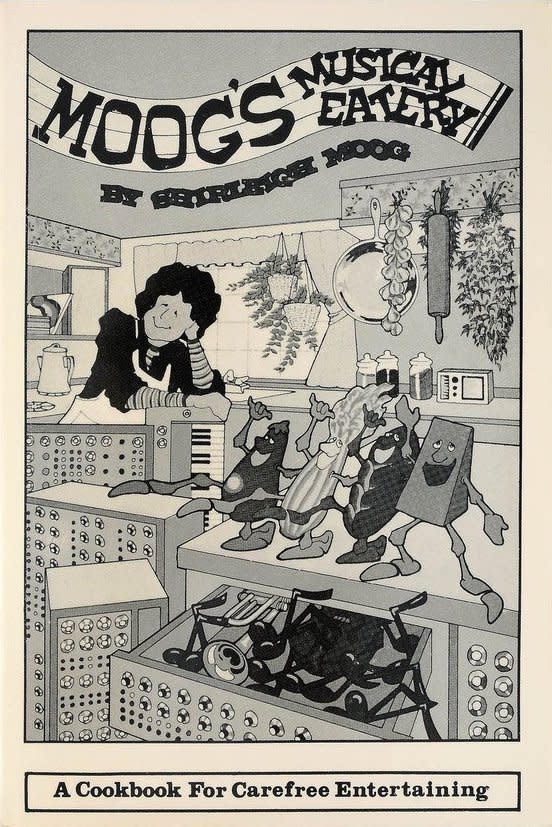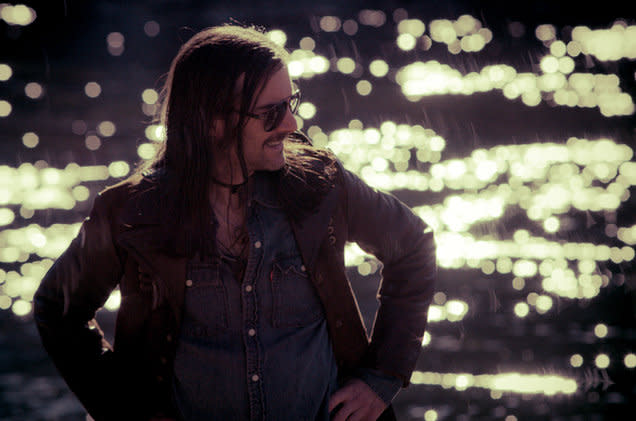The Moog Cookbook talk '90s synth spoofs: 'We sank our teeth into songs we wanted to destroy and make gross'

Roger Joseph Manning Jr., who releases his solo EP Glamping this week, made his mark in the 1990s as a founding member of powerpop darlings Jellyfish (and he now plays keyboards for ’90s icon Beck, alongside ex-Jellyfish member Jason Falkner). But perhaps Manning’s most unusual — and most overlooked — ’90s achievement was the Moog Cookbook.
Known as one of the “weirdest bands in the world,” the Moog Cookbook had a brief career, but the robot-helmeted parody duo garnered famous fans like Air (who recruited Manning and his musical partner Brian Kehew for tours and remixes), MTV VJ Kurt Loder (who excitedly had them perform on The Week in Rock), and even Daft Punk. The Moog Cookbook were in fact later heralded as the precursors to Daft Punk, although their style could be more accurately described as Daft Punk-meets-Weird Al.

Some background: As the new millennium and all its promise of hoverboards and threats of Y2K meltdown came hurtling towards us back in 1996, the Moog Cookbook arrived in their proto-Daft Punk headgear and metallic spacesuits to whisk adventurous pop fans to the final frontier of awesomeness. On their now demi-legendary self-titled CD of New Wave Muzak, this dynamic duo, of Uli Nomi (aka Manning) and Mecco Eno (aka record producer/Who keyboard tech/Recording the Beatles author Kehew), employed a smorgasbord of vintage analog equipment to vacuum-pack alt-rock songs of the era. Green Day’s “Basket Case,” Soundgarden’s “Black Hole Sun,” Weezer’s “Buddy Holly,” and Nirvana’s “Smells Like Teen Spirit” were among the many ’90s guitar hits they thickly coated with their tasty processed audio cheese.
FYI, the food analogies in the above paragraph are apt: The twosome’s name was inspired by the cookbook Moog’s Musical Eatery penned in 1978 by Shirleigh Moog, first wife of synthesizer pioneer Robert Moog.
While the duo never received the widespread recognition they deserved, their debut album and the classic rock-themed follow-up, Ye Olde Space Bande (which synth-skewered Ted Nugent, Boston, Lynyrd Skynyrd, and Van Halen, and even featured Devo’s Mark Mothersbaugh on “Ain’t Talkin’ ‘Bout Love”), are now cult classics. And the project is still a highlight on Manning’s résumé.

Check out an archival interview below with Manning and Kehew, which serves up just about everything from Buck Owens to Buck Rogers. Bon appétit, synth fans!
Yahoo Entertainment: So how did you come up with this idea to form an all-covers, instrumental Moog band?
Brian Kehew: There’s a genre of records that came out when the synthesizer first became popular — 1968 and ’69 — where people first did instrumental Moog covers of pop songs. Moog Plays the Beatles, Switched on Bacharach, a country album called The Plastic Cow Goes Moog… This was mostly 1969. And then around 1970 or 1971 — boom! They stopped, because it was no longer a novelty. Like breakdancing later on after the ’80s, it just went away. People still used Moogs, but in a nicer, Stevie Wonder-type way. Anyway, Roger and I, in our separate little lives, collected these albums.
Roger Joseph Manning Jr.: When Brian and I finally met, we knew we had to do this, because we knew we could do it right, and we knew we had the resources — before someone else did it, and did it wrong.
Kehew: We both had a background, like a lot of keyboard players do, where it’s jazz, it’s progressive rock, it’s new wave — we didn’t differentiate. If it had synthesizers in it, it was cool, whether it was Loverboy or Brian Eno or Tangerine Dream. We’re influenced by all that stuff, and we’re influenced by Stevie Wonder and Kraftwerk, too. But it all started as the 1969 Moog album of the modern day, and that’s pretty much where it stayed.
Yahoo Entertainment: How did you choose the songs to cover?
Manning: Well, we knew we wanted to concentrate on bastardizing alternative hits. We couldn’t wait to sink our teeth into songs we wanted to destroy and make really gross. One of my favorites is “Basket Case,” because we took what is supposed to be a punk anthem and, through the power of arranging, turned it into the grossest thing in the world. The fun part was taking what was supposed to be such a hard-edged, masculine, testosteroned tune, and sugar-coating the hell out of it. We didn’t change any of Green Day’s melody or infrastructure; we just added syrupy arrangement ideas.
Kehew: We would not reject any bad idea, that’s for sure. It was very difficult to pick songs, though, because a lot of modern songs cannot be played instrumentally because they’re all some guy or girl screaming, or all feel.
Manning: A song like “Black Hole Sun” happened so quickly because it has such a wonderful melody. So you can do anything you want to it, and it kind of ends up making you sound good! Other songs almost killed us, like [Pearl Jam’s] “Evenflow,” because all of Eddie Vedder’s supposed melody is sort of a blues scat.
Yahoo Entertainment: How did you do what I like to call, for lack of a more official term, the “Speak ‘N’ Spell” voice?
Kehew: With a tube in my mouth. The “Framptone,” as I like to call it. We wanted a Speak ‘N’ Spell thing but we couldn’t find one, and there are computers where you can type it in, but I couldn’t find one that was antiquated; everyone has new versions with pitch and inflection, and I was like, “No, I want monotone!” Roger was on the floor when I was doing it, it was so funny. He had to leave the room so I could finish it.
Yahoo Entertainment: So when you were going about the arranging, did you think, “This one’s going to be our Eurodisco song,” or “Here’s our Muzak song”? What went through your minds?
Kehew: Well, the first one was “Black Hole Sun,” and we said, “What are we going to do?” And I looked at the drum machine and said, “Bossanova!” And I hit the button. Or like for the Offspring’s “Come Out and Play,” I really wanted to do “I Feel Love” by Donna Summer.
Manning: Or, more specifically, Giorgio Moroder.
Kehew: Right. And I figured, if we’re gonna do a 1976 thing, we might as well have a Star Wars laser battle at the end!
Yahoo Entertainment: How long have you guys been playing and collecting keyboards?
Kehew: I’ve been playing since I bought my first synthesizer in 1977. I’ve still got it. It was an Arp Odyssey — a classic progressive rock synthesizer. The Steve Miller Band and Devo used it a lot. But I could never afford all those keyboards, because all the keyboards that I read about in Keyboard magazine were going for $5,000. And then five years later, they’d be two grand. Then a thousand. And then I was buying them in pawn shops for $150, because nobody wanted them anymore.
Manning: That’s the one good thing that came out of grunge, is that everybody was in heavy guitar bands and hated keyboards. You did not play a synthesizer, because it was uncool. So keyboards got very cheap.
Kehew: We were buying them when no one wanted them, like people used to do with Brady Bunch lunchboxes. Now Moogs are worth so much money, and climbing.
Yahoo Entertainment: How did you two meet?
Manning: In my never-ending search for old gear, Brian had a keyboard for sale in The Recycler, so I went to check it out, and we immediately hit it off. Anybody whose favorite pastime is watching the Sgt. Pepper movie is a friend of mine!
Kehew: Billy Preston saves that movie in the end, when he comes out dancing in his boots.
Manning: I thought George Burns saved it, personally.
Kehew: What about Starguard, the ladies who sing “Lucy in the Sky With Diamonds” [in that movie]? We have some of their costumes. The music store that I worked at got a flight case that said “STARGUARD” on the side of it, so we opened it up and it was all costumes, big silver platform shoes, stuff like that.
Manning: Anyway, so Brian and I started networking together, helping each other find keyboards. We’ve loaned each other money to help each other buy stuff.
Kehew: Yeah, or Roger would call me up and say, “I found two mint-green electric pianos that look like they’re on space pedestals in some guy’s garage in Fullerton!” And I’d be like, “OK, I’ll rent a trailer!”
Yahoo Entertainment: Let’s talk about some of the “Moogspirations” in your debut album’s liner notes. Why is Neil Young in there, for instance?
Kehew: Neil Young has a synthesizer album that is absolutely amazing. It’s all synthesizer, from 1983, called Trans. It’s Neil, but it’s all synthesizers and all computerized, and the songs are great. I have a concert film of this tour where he wears Devo glasses and he’s running around singing through a talkbox, and the people in the audience are just so bummed. They are not happy. It was his least popular album, but we think it’s his best.
Manning: It’s so funny that he’s adored for these classic works that he did decades ago, and Brian and I are going, “My God, this Trans album is one of the most overlooked works of brilliance!”
Kehew: He even redid one of his old Buffalo Springfield songs, “Mr. Soul,” in a synthesizer version, and that really pissed people off. The album is not available on CD. They won’t make it.
Yahoo Entertainment: OK, why did you thank George Harrison in your liner notes?
Kehew: He did an all-Moog album. It was one of the first Beatles solo records. It’s totally hard to find, but it’s called Electronic Sound. It’s all Moog; there’s no rhythms, no drum machine. It’s really bad synthesizer music, and I love it. It’s just a guy noodling for two hours. It’s full of cool sounds, and that’s all there is. No music or songs, just noise. It’s probably the most un-liked Beatles-related album of all time.
Manning: You’d definitely put it on to entertain everybody at a loft party at Magic Alex’s place!
Yahoo Entertainment: You also thank Buck Owens.
Kehew Buck Owens actually beat out the Monkees by buying a Moog first. He did his Switched on Buck album. Buck did a synthesizer years before Neil thought of it. Imagine, country fans hearing a synth album!
Yahoo Entertainment: You also thank Tran-Star. Who are they? Not to be confused with Starguard, I presume…
Manning: Oh my God, they’re the best band ever!
Kehew: Down at Disneyland, in the late ’80s, they had a little space van, kind of like how you’d see on Sunday morning cartoons, and these three guys would hop out wearing space suits. There was a sound system built into the van, and they had two weird space keyboards and a strange diamond-shaped guitar, and they talked through little tubes and played computer-synthesizer versions of pop hits, like “Wild Wild West” by the Escape Club. They’d also do stuff like “Someday My Prince Will Come.” I became friends with them. We used to go downstairs under Disneyland and hang out.
Manning: They were amazing. Total space-funk. Very Buck Rogers.
Kehew: One reason we liked them so much is they used to make fun of Disneyland, in Disneyland! They’d say stuff like, “There goes Snow White; I heard that’s just her nickname.” I asked them how they got away with it, and they said, “We run our voices through a machine, so I don’t think they can really understand us.”

Yahoo Entertainment: And finally, tell me why you thank “Monica West & Roland Grand, aka Starock“? Again, not to be confused with Starguard?
Manning: They were a husband-and-wife team that lived in San Francisco in the early ’80s, who had a public access cable show called SFTV. But it was mainly a vehicle to showcase homemade videos by their own band, Starock. It was basically Roland, a hippie who never cut his hair and looked like Uli Roth from Scorpions, playing New Wave on two synthesizers, and Monica would sing. She was a self-proclaimed blues singer who looked like Jeff McDonald from Redd Kross crossed with Linda McCartney. Their homemade videos were shot in their rehearsal room, and whenever you saw Roland playing drums, he would be projected on a separate video monitor, so they could have three people playing at the same time instead of two. When we were living in San Francisco, we videotaped all their shows; they were always on public access on Friday nights. Everyone would be like, “Come on, let’s go to the clubs,” and we’d say, “Screw that, we’re staying home to watch some Starock!”
Yahoo Entertainment: I think you made the right decision.
Read more from Yahoo Entertainment:
Neil Young to finally release animated ‘Trans’ film: ‘People will hear the album the way I wanted’
‘Thor: Ragnarok’ composer Mark Mothersbaugh on breaking out his Devo keyboards for Marvel
Beck salutes Tom Petty, Los Angeles at epic hometown-hero show
Follow Lyndsey on Facebook, Twitter, Instagram, Google+, Amazon, Tumblr, Spotify

